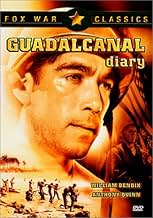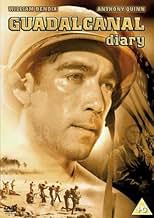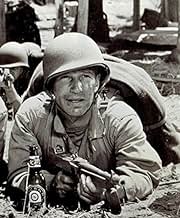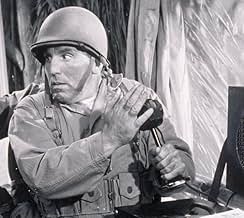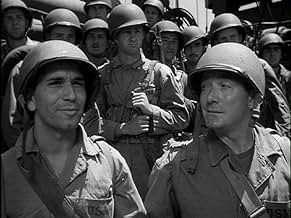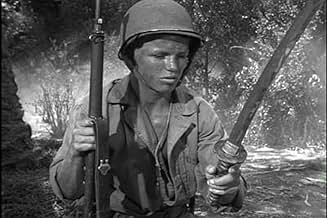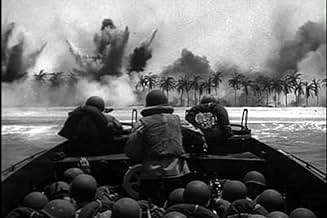CALIFICACIÓN DE IMDb
6.7/10
2.4 k
TU CALIFICACIÓN
Agrega una trama en tu idiomaThe story of a large U.S. Marines invasion task force bound for Guadalcanal in the Solomon Islands in 1942.The story of a large U.S. Marines invasion task force bound for Guadalcanal in the Solomon Islands in 1942.The story of a large U.S. Marines invasion task force bound for Guadalcanal in the Solomon Islands in 1942.
- Dirección
- Guionistas
- Elenco
- Premios
- 1 premio ganado en total
Eddie Acuff
- Pvt. Tex Mcllvoy
- (sin créditos)
Warren Ashe
- Col. Morton
- (sin créditos)
Martin Black
- Marine
- (sin créditos)
Marion Carl
- Marine Pilot
- (sin créditos)
Harry Carter
- Dispatch Officer
- (sin créditos)
Tom Dawson
- Captain
- (sin créditos)
Opiniones destacadas
Guadalcanal is the second largest island (after Bougainville) of the Solomons and largest of the Solomon Islands Protectorate southwest Pacific...
During World War II it was the scene of bitter land and sea fighting between U. S. and Japanese forces...
On August 1942, the U.S. Marines, in the Allies' first major offensive in the Pacific, seized a Japanese airfield, Henderson Field, on the island...
On November, in a naval engagement, the Allies prevented the Japanese from landing reinforcements... By February 1943 the Japanese, badly outnumbered, were forced to evacuate Guadalcanal and by the end of the year they were on the defensive in their last stronghold in the Solomons, Bougainville Island...
"Guadalcanal Diary" is based on the best-selling book by war correspondent Richard Tregaskis... It follows the career of a platoon of Marines from Pre-landing shipboard briefings through two months slow murderous fighting in the taking of the South Sea jungles...
The film gives a realistic view of the hardships of war, and has its moments... Perhaps the most touching scene is at the climax when the tired veterans watch the fresh, green troops marching past them... The feeling is one of a continuous hard effort... The impudent newcomers have yet to face the revolting horrors that an American soldier is subjected to... Certainly, they will fight as well as those before them, however, we cannot but help feeling sad for those who will never return...
The film reveals the hard life in camps, shelters, patrols, hospitals, beaches and jungles in absolute reality... It is terse, violent, close in atmosphere and technique to "Wake Island" (1942).
During World War II it was the scene of bitter land and sea fighting between U. S. and Japanese forces...
On August 1942, the U.S. Marines, in the Allies' first major offensive in the Pacific, seized a Japanese airfield, Henderson Field, on the island...
On November, in a naval engagement, the Allies prevented the Japanese from landing reinforcements... By February 1943 the Japanese, badly outnumbered, were forced to evacuate Guadalcanal and by the end of the year they were on the defensive in their last stronghold in the Solomons, Bougainville Island...
"Guadalcanal Diary" is based on the best-selling book by war correspondent Richard Tregaskis... It follows the career of a platoon of Marines from Pre-landing shipboard briefings through two months slow murderous fighting in the taking of the South Sea jungles...
The film gives a realistic view of the hardships of war, and has its moments... Perhaps the most touching scene is at the climax when the tired veterans watch the fresh, green troops marching past them... The feeling is one of a continuous hard effort... The impudent newcomers have yet to face the revolting horrors that an American soldier is subjected to... Certainly, they will fight as well as those before them, however, we cannot but help feeling sad for those who will never return...
The film reveals the hard life in camps, shelters, patrols, hospitals, beaches and jungles in absolute reality... It is terse, violent, close in atmosphere and technique to "Wake Island" (1942).
Considering that this was a WWII movie released in 1943,while the war was still going and a ways from being resolved,this movie was probably as effective and convincing as you were going to get for the period. Certainly,given the state of the nation's need to keep the national morale up for the war effort,anything too graphic or too gritty would(besides probably raise the dander of the censorship standards of the day)probably would've deflated the efforts to get stateside citizenry to buying war bonds,cutting usage of certain products(metals come first to mind)and probably would've helped undercut the Roosevelt administrations efforts to keep the war push at the rate it was going. If it's too soft,it becomes mostly jingoistic and loses just about all of the entertainment value it could possibly have. Fortunately(perhaps by design,maybe not),the makers of this movie were able to strike the right--if perhaps unremarkable--balance.
Being a grandchild of the generations being showcased here(erstwhile known by some as "The Greatest Generation"),I have only stories told or written about the two theaters of war effort,not to mention the movies. Of course,as more years would pass between the conclusion of that war,the movies that would be made(many of them sprung from books)would become grittier,harsher,a little less glossy or idealistic,and ultimately,more graphically violent. THerefore,I(And I'm guessing many of my generation)could view this movie somewhat jadedly: the dialog is so simple and full of gaps that it almost feels like it could be parodied on Mystery Science Theatre 3000,add in the fact that many of the "kills" and soldiers dropping dead are noticeably staged and forced looking and you have a film that might have a hard time being instantly compelling to people who've seen things ranging from The Great EScape to Saving Private Ryan. Still,there ARE saving graces to this movie that make it stand the test of time:
--The earnest and no-nonsense portrayal of battle and the basic emotions between MArines,from deployment aboard a battleship carrier,right on through the two month battle to claim and seal off the island,is honest enough that anyone who's been through battle,known someone who has been(or still is)at war can feel some common relationship with the characters in the film. Some poignant lines are spoken by the perceived comic relief of the film(a brash,slightly dense private from Brooklyn played by luggish William Bendix)and the wise yet quietly strong chaplain(Preston Brooks),among others,to give this film some heft and
--The battle scenes are concise and tight,showcasing plenty of gunfire,explosions,bombings and other various forms of combat violence WITHOUT being tedious or trivial. They are not neat,pretty or always with the desirable outcomes,but they are neither futile nor random.
MOst of the characters here seem like composites,no doubt probably an amalgam of (Mostly)young MArines and Army men that script co-writer(with Lamar Trotti) and book source writer Richard Tregaskis met while covering the Pacific Theatre of Operations in the war. I imagine there was pressure on the studio and director Lewis Seiler to crank out this film as fast as possible to stoke the fires of stateside interest in the war effort,so if the finished product doesn't exactly shine,I think he and the people making this movie can be forgiven. All in all,this is a film to recommend for those who are curious about movies set around WWII,particularly films about it that are IN the moment,when America was only able to have so much perspective on it.
Being a grandchild of the generations being showcased here(erstwhile known by some as "The Greatest Generation"),I have only stories told or written about the two theaters of war effort,not to mention the movies. Of course,as more years would pass between the conclusion of that war,the movies that would be made(many of them sprung from books)would become grittier,harsher,a little less glossy or idealistic,and ultimately,more graphically violent. THerefore,I(And I'm guessing many of my generation)could view this movie somewhat jadedly: the dialog is so simple and full of gaps that it almost feels like it could be parodied on Mystery Science Theatre 3000,add in the fact that many of the "kills" and soldiers dropping dead are noticeably staged and forced looking and you have a film that might have a hard time being instantly compelling to people who've seen things ranging from The Great EScape to Saving Private Ryan. Still,there ARE saving graces to this movie that make it stand the test of time:
--The earnest and no-nonsense portrayal of battle and the basic emotions between MArines,from deployment aboard a battleship carrier,right on through the two month battle to claim and seal off the island,is honest enough that anyone who's been through battle,known someone who has been(or still is)at war can feel some common relationship with the characters in the film. Some poignant lines are spoken by the perceived comic relief of the film(a brash,slightly dense private from Brooklyn played by luggish William Bendix)and the wise yet quietly strong chaplain(Preston Brooks),among others,to give this film some heft and
--The battle scenes are concise and tight,showcasing plenty of gunfire,explosions,bombings and other various forms of combat violence WITHOUT being tedious or trivial. They are not neat,pretty or always with the desirable outcomes,but they are neither futile nor random.
MOst of the characters here seem like composites,no doubt probably an amalgam of (Mostly)young MArines and Army men that script co-writer(with Lamar Trotti) and book source writer Richard Tregaskis met while covering the Pacific Theatre of Operations in the war. I imagine there was pressure on the studio and director Lewis Seiler to crank out this film as fast as possible to stoke the fires of stateside interest in the war effort,so if the finished product doesn't exactly shine,I think he and the people making this movie can be forgiven. All in all,this is a film to recommend for those who are curious about movies set around WWII,particularly films about it that are IN the moment,when America was only able to have so much perspective on it.
Hard hitting war movie about the first land offensive by the US in the Pacific Theater of War. Linking up with a US Navy battle task force in the South Pacific, in late July 1942, a US Marine troop ship gets the word that it's men are to be part of the invasion of the Japanese held Solomon Islands landing at a place called Gudalcanal.
Heading the invasion force is Marine Col.Wallace Grayson, Minor Watson, of the 1st. Marine Div. who's told to expect stiff resistance when his men hit the beach. As D-Day, August 7, 1942, approaches there's an eerie feeling among the Marines on deck that this first land battle is going to be a lot different then any thing that they could possibly imagined, they were right.
Powerhouse cast headed by Marine Chaplin Father Donnelly, Preston Foster, with tough as nails Marine Sgt. Hook Malone, Llyod Noland, and young 17 year old Richard Jackel as the baby-face and non-shaving Pvt. Johnny "Chicken" Anderson storm ashore on Gaudalcanal only to find that the Japanese are nowhere to be found and the "stiff resistance" that they expected was almost non-existent. Caught off guard and by surprise the Japanese defenders took off in the jungles and caves on the island. It's there that they waited to be reinforces by fresh Nippon army and marine units from the neighboring Japanese-held islands of Rabaul and Bouganinvillea.
With the US Marines capturing the Japanese air-field on the island, renaming it Henderson Field, and having much needed supplies flown in everything look up for the leathernecks and the battle of Guadalcanal seems just about over. The truth later turned out to be that the battle only began and would last some eight months. In the end Gaudalcanal would cost the US Marines Army and Navy some 20,000 casualties by the time it was over.
Far more realistic then most of the movies made by Hollywood in WWII about WWII "Guadalcanal Diary" keeps the action up and the the false heroics down. Making the Marines in the movie more human with real emotions and feeling about surviving the battle and coming back home when the war's finally over.
We also see the Japanese as both tough and effective, as well as cunning,soldiers not the wild-eyed and mindless fanatics were used to seeing, in the many war movies released back then. Thus giving the American public a better idea of what the men in both the US Marines and Army were fighting in the war in the Pacific.
The US Marines at first being told by a captured Japanese soldier that his unit is ready to surrender send a patrol to the off-shore island village of Matanikau only to find that the Japanese troops waiting for them. In an ambush the Japanese wiped out the entire Marine patrol, including it's commanding officer Capt. Cross ,Roy Roberts. Cpt. Alvarez, Anthony Quinn, was the only survivor who escapes by swimming out at sea. It now becomes apparent that the Japanese are not giving up that easily and the Maines dig in for the major battles that are soon to come.
In a tough sea air and land campaign the US and Japanese forces slug it out as the Japanese Navy tries to cut off reinforcements to the Marines on the Island. Leaving them isolated and sitting ducks for their massive naval and air attacks. The fighting goes on unabated until the US finally breaks through the Japanese blockade. As new Army as well as Marine unites land on the Island, and on Novermber 11, 1942 launch a major counter-attack that clears Gudalcanal of Japanese troops. The Japanese, unlike in the movie, were successfully evacuated by sea not massacred on the beaches by the Marines and GI's. Still the battle of Gudalcanal was the first of many Japanese held island taken by US forces that eventually lead to the defeat of Japan in the late summer of 1945.
With all the action and heroics in the movie the most moving scene in the film is when the Marines, underground in their bunker, are being hit by a nerve wracking and murderous Japanese naval and air bombardment. The Marines acted like you would expect to act under the same circumstances, scared and afraid. Cpl. Aloysius "Taxi" Potts, William Bendix, put it best when he says "I'm no hero I'm just a guy I've come out her because somebody had to come, I don't want no medals I just want to get this over with and go back home".
Heading the invasion force is Marine Col.Wallace Grayson, Minor Watson, of the 1st. Marine Div. who's told to expect stiff resistance when his men hit the beach. As D-Day, August 7, 1942, approaches there's an eerie feeling among the Marines on deck that this first land battle is going to be a lot different then any thing that they could possibly imagined, they were right.
Powerhouse cast headed by Marine Chaplin Father Donnelly, Preston Foster, with tough as nails Marine Sgt. Hook Malone, Llyod Noland, and young 17 year old Richard Jackel as the baby-face and non-shaving Pvt. Johnny "Chicken" Anderson storm ashore on Gaudalcanal only to find that the Japanese are nowhere to be found and the "stiff resistance" that they expected was almost non-existent. Caught off guard and by surprise the Japanese defenders took off in the jungles and caves on the island. It's there that they waited to be reinforces by fresh Nippon army and marine units from the neighboring Japanese-held islands of Rabaul and Bouganinvillea.
With the US Marines capturing the Japanese air-field on the island, renaming it Henderson Field, and having much needed supplies flown in everything look up for the leathernecks and the battle of Guadalcanal seems just about over. The truth later turned out to be that the battle only began and would last some eight months. In the end Gaudalcanal would cost the US Marines Army and Navy some 20,000 casualties by the time it was over.
Far more realistic then most of the movies made by Hollywood in WWII about WWII "Guadalcanal Diary" keeps the action up and the the false heroics down. Making the Marines in the movie more human with real emotions and feeling about surviving the battle and coming back home when the war's finally over.
We also see the Japanese as both tough and effective, as well as cunning,soldiers not the wild-eyed and mindless fanatics were used to seeing, in the many war movies released back then. Thus giving the American public a better idea of what the men in both the US Marines and Army were fighting in the war in the Pacific.
The US Marines at first being told by a captured Japanese soldier that his unit is ready to surrender send a patrol to the off-shore island village of Matanikau only to find that the Japanese troops waiting for them. In an ambush the Japanese wiped out the entire Marine patrol, including it's commanding officer Capt. Cross ,Roy Roberts. Cpt. Alvarez, Anthony Quinn, was the only survivor who escapes by swimming out at sea. It now becomes apparent that the Japanese are not giving up that easily and the Maines dig in for the major battles that are soon to come.
In a tough sea air and land campaign the US and Japanese forces slug it out as the Japanese Navy tries to cut off reinforcements to the Marines on the Island. Leaving them isolated and sitting ducks for their massive naval and air attacks. The fighting goes on unabated until the US finally breaks through the Japanese blockade. As new Army as well as Marine unites land on the Island, and on Novermber 11, 1942 launch a major counter-attack that clears Gudalcanal of Japanese troops. The Japanese, unlike in the movie, were successfully evacuated by sea not massacred on the beaches by the Marines and GI's. Still the battle of Gudalcanal was the first of many Japanese held island taken by US forces that eventually lead to the defeat of Japan in the late summer of 1945.
With all the action and heroics in the movie the most moving scene in the film is when the Marines, underground in their bunker, are being hit by a nerve wracking and murderous Japanese naval and air bombardment. The Marines acted like you would expect to act under the same circumstances, scared and afraid. Cpl. Aloysius "Taxi" Potts, William Bendix, put it best when he says "I'm no hero I'm just a guy I've come out her because somebody had to come, I don't want no medals I just want to get this over with and go back home".
War correspondent Richard Tregaskis's memoir of the battle for the strategic island of Guadalcanal provides the basis of this film with a solid cast of players. Tregaskis himself is played unnamed in the film by Reed Hadley, who's rich narrative voice greatly enhances the film.
Guadalcanal Diary unfortunately has not aged well. It was made the year after Guadalcanal, together with its key airfield Henderson Field was finally cleared of Japanese. It was a slow, steady war of attrition, on both land and sea. While this film concerns the Marines on the island, at sea our navy was battling with the Japanese Navy in what was euphemistically called 'the slot' which was a channel that bisected the Solomon chain neatly in half. Our Marines dealt not only with the Japanese on the ground, but from Naval bombardment from the Japanese Fleet whenever they snuck in. The Japanese positions were in the jungle and further in land and were less affected by off shore shelling from us.
All the types you expect from World War II are there, the tough Marine sergeant Lloyd Nolan, the Marine from Brooklyn, where else, William Bendix, the young recruit, Richard Jaeckel in his first film playing a teenager when he actually was one. Preston Foster plays the Catholic chaplain, a wise and compassionate fellow who once played football for Notre Dame. It's a page out of Pat O'Brien's Father Duffy portrayal from The Fighting 69th and Foster is the best one in the film.
Sad to say that the Marines do refer to the Japanese as less than human on a few occasions. It's why the film doesn't age well, especially after Clint Eastwood's latest films about the Pacific Theater.
Guadalcanal Diary still is a good film for those who are fans of World War II films made in the World War II years.
Guadalcanal Diary unfortunately has not aged well. It was made the year after Guadalcanal, together with its key airfield Henderson Field was finally cleared of Japanese. It was a slow, steady war of attrition, on both land and sea. While this film concerns the Marines on the island, at sea our navy was battling with the Japanese Navy in what was euphemistically called 'the slot' which was a channel that bisected the Solomon chain neatly in half. Our Marines dealt not only with the Japanese on the ground, but from Naval bombardment from the Japanese Fleet whenever they snuck in. The Japanese positions were in the jungle and further in land and were less affected by off shore shelling from us.
All the types you expect from World War II are there, the tough Marine sergeant Lloyd Nolan, the Marine from Brooklyn, where else, William Bendix, the young recruit, Richard Jaeckel in his first film playing a teenager when he actually was one. Preston Foster plays the Catholic chaplain, a wise and compassionate fellow who once played football for Notre Dame. It's a page out of Pat O'Brien's Father Duffy portrayal from The Fighting 69th and Foster is the best one in the film.
Sad to say that the Marines do refer to the Japanese as less than human on a few occasions. It's why the film doesn't age well, especially after Clint Eastwood's latest films about the Pacific Theater.
Guadalcanal Diary still is a good film for those who are fans of World War II films made in the World War II years.
Like BATAAN and WAKE ISLAND, GUADALCANAL DIARY is another of the many gripping war films that captured attention during WWII, complete with narration by Reed Hadley as the war correspondent telling the story of how U.S. Marines fought and died at Guadalcanal. At first, the marines met no resistance since the Japanese had scattered, but soon the battles became fierce and the war drama deepens.
A stalwart cast of players gives life to the many characters, some stereotypes to be sure, but vivid, nonetheless. Interesting how RICHARD JAECKEL managed to be in just about every war film ever made during the '40s and well into future decades, still keeping his fresh-faced appeal as a baby-faced Marine. PRESTON FOSTER is the leader here, filling the sort of role usually held by Brian Donlevy, and the assorted cast members include ANTHONY QUINN, LLOYD NOLAN, RICHARD CONTE, RALPH BYRD and the ever present WILLIAM BENDIX as the guy from Brooklyn.
There's plenty to admire about the gritty and realistic battles and the overall quality of the performances, and sure, it's propaganda, the kind America needed at the time to keep morale high during the war, but it's well worth watching as a reminder of the sacrifices all these men made on behalf of our freedom today.
Trivia note: Just read Christopher Mulrooney's review of this film and you have to wonder what planet he's coming from.
A stalwart cast of players gives life to the many characters, some stereotypes to be sure, but vivid, nonetheless. Interesting how RICHARD JAECKEL managed to be in just about every war film ever made during the '40s and well into future decades, still keeping his fresh-faced appeal as a baby-faced Marine. PRESTON FOSTER is the leader here, filling the sort of role usually held by Brian Donlevy, and the assorted cast members include ANTHONY QUINN, LLOYD NOLAN, RICHARD CONTE, RALPH BYRD and the ever present WILLIAM BENDIX as the guy from Brooklyn.
There's plenty to admire about the gritty and realistic battles and the overall quality of the performances, and sure, it's propaganda, the kind America needed at the time to keep morale high during the war, but it's well worth watching as a reminder of the sacrifices all these men made on behalf of our freedom today.
Trivia note: Just read Christopher Mulrooney's review of this film and you have to wonder what planet he's coming from.
¿Sabías que…?
- TriviaMarine Corps Capt. Marion Carl, a multi-ace (18.5 air victories), makes an appearance as a Marine Corps pilot. Capt. Carl wears his baseball cap with the bill pointed skyward and makes the comment, "Don't look now, fellas, but a truck of gas just came on the field." Capt. Carl was a survivor of the Battle of Midway and the air campaign for Guadalcanal in 1942. He was awarded 2 Navy Crosses for his actions at Midway and Guadalcanal. Sadly, on June 28, 1998, he was murdered in his Oregon home by a home intruder.
- ErroresWhen Japanese snipers hid in the tops of trees, they tied themselves into their positions. They did not fall out of the trees when shot.
- Citas
Cpl. Aloysius T. 'Taxi' Potts: [In dugout waiting out a heavy artillery barrage] I don't mind the one with my name on it. It's the one that says, 'To whom it may concern' that I don't like.
[after the barrage increases]
Cpl. Aloysius T. 'Taxi' Potts: They're throwing everything at us but the kitchen stove.
Gunnery Sgt. Hook Malone: [after an even louder explosion] That's the stove now!
- Créditos curiososThe film's opening prologue in the preface of a book states: A new chapter in the history of America by a correspondent who landed on Guadalcanal with the first detachment of United States Marines.
- ConexionesEdited into El asalto a Tarawa (1958)
- Bandas sonorasMarine Hymn
(uncredited)
Music by Jacques Offenbach from "Geneviève de Brabant"
Played during the opening credits and occasionally in the score
Selecciones populares
Inicia sesión para calificar y agrega a la lista de videos para obtener recomendaciones personalizadas
- How long is Guadalcanal Diary?Con tecnología de Alexa
Detalles
- Fecha de lanzamiento
- País de origen
- Idioma
- También se conoce como
- Richard Tregaskis' Guadalcanal Diary
- Locaciones de filmación
- Productora
- Ver más créditos de la compañía en IMDbPro
- Tiempo de ejecución
- 1h 33min(93 min)
- Color
- Relación de aspecto
- 1.37 : 1
Contribuir a esta página
Sugiere una edición o agrega el contenido que falta


